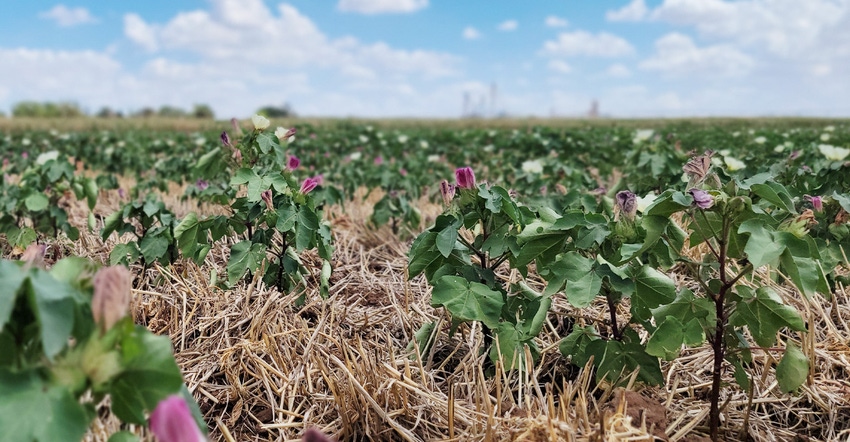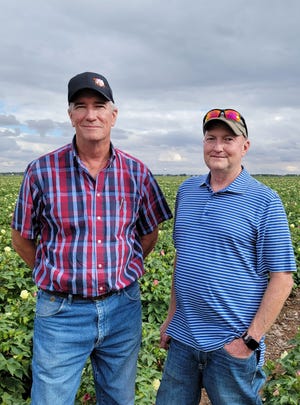
"This year has been one for the record," says Kody Bessent, Plains Cotton Growers CEO, "probably even more difficult than what we saw in 2011, which has kind of been the benchmark we've used for one of the worst years we've had on record."
Texas's drought and limited irrigation combined with triple-digit temperatures have left behind a high percentage of unharvestable cotton acres and fallow fields where failed cotton was plowed under earlier in the season.
"We're certainly going see a lot of abandonment. We don't have those numbers yet, but we're probably pretty close to 65% to 70% abandonment throughout the area," Bessent says.
 Plains Cotton Growers CEO Kody Bessent, right, talks about cotton production on the High and South Plains of Texas with Producer Information Education (P.I.E.) participants, including Alabama producer Andy Armstrong, Dothan. Farm Press visited Bessent before the P.I.E. tour began. (Photo by Shelley E. Huguley)
Plains Cotton Growers CEO Kody Bessent, right, talks about cotton production on the High and South Plains of Texas with Producer Information Education (P.I.E.) participants, including Alabama producer Andy Armstrong, Dothan. Farm Press visited Bessent before the P.I.E. tour began. (Photo by Shelley E. Huguley)
"Producers do have good risk management tools through crop insurance that helps mitigate some of that risk."
The loss doesn't end on the farm. Bessent says it dominos throughout the infrastructure to cotton gins, warehouses and merchants. "Their income relies on volume of production, so you see a lot of strain and stress and challenges in those segments."
Domino Effect
Paul Wilson, United Cotton Growers general manager, Levelland, says on average, United gin's 130,000 bales to 170,000 bales with the capacity to gin 200,000. "This year we'll do between 20,000 and 40,000 (bales). It's not only been the drought, but also the tremendous heat. Many, many days over 100 degrees. It's just really been difficult."
United Cotton Growers is diversified generating income beyond the gin, something Wilson says will be beneficial in 2022. "In a year like this, when the crop's going to be down and our income down, that diversification helps offset the loss on the ginning side."
To compensate for the reduction in acres, Wilson says they won't operate the gin 24/7 but rather cut back to one 12-hour shift per day. "That way it will fit with the harvesting a bit better. By going to one shift, we'll be able to extend our season and that will help the employees. One crew we won't bring in but our full-time guys we'll keep them and give them more hours."
 United Cotton Growers General Manager Paul Wilson, left, and producer and United Cotton Growers board member David Carter, both of Levelland, stand in Len Stanley's Pima/Upland cross cotton field during the P.I.E. tour. Wilson and Carter gave field tours. (Photo by Shelley E. Huguley)
United Cotton Growers General Manager Paul Wilson, left, and producer and United Cotton Growers board member David Carter, both of Levelland, stand in Len Stanley's Pima/Upland cross cotton field during the P.I.E. tour. Wilson and Carter gave field tours. (Photo by Shelley E. Huguley)
Because of the short crop and since the gin is designed to gin so quickly (14,000 to 15,000 bales per week), Wilson says if they were to run the gin 24 hours a day, it would constantly run out of cotton. "The producers won't be able to harvest it as fast as we can gin it. Our ginning capacity is bigger than the crop."
Wilson has encouraged growers to harvest what cotton they have in a timely manner, which will also help reduce gin expenditures. "We're going to keep the costs down as much as we can. The gin will be in great shape going into 2023, so we won't have a lot to do next year. We'll be ready to go."
Bessent says he's heard talk of gins combining for this season and ginning from one location to conserve utilities and financial resources. In larger companies within the industry, he's also heard of employee terminations due to a lack of financial capabilities to keep either seasonal or full-time employees. "That's unfortunate. It's very sad but it's something the industry is being faced with this year in our region."
Bessent describes it as a domino effect. "If you've got the seven cotton industry segments from the producers all the way through the exporters, all of them will feel some sort of pinch throughout their segment because of the lack of volume."
Communities will also feel the pinch. "You'll see restaurants feel that pain because there's less disposable income, so less people going out to eat, less people spending at the grocery store," Bessent says.
"Our whole area is drawing on the farming economy from a huge footprint and an economic impact. So, when ag does well, the overall economy does well. When ag doesn't do so well, like the year we're setting up to have, the overall economy feels that pinch."
2011
This year's drought is often compared to 2011. "In 2011, we had decent subsoil moisture going into 2011 from a planting intension perspective, versus this year, we had zero subsoil moisture. So, people were already behind the eight-ball trying to get a crop established and keep it going. But we've had hot, high temperatures. In July, we had the highest record amount of 100-degree temperatures historically than we've ever seen in Lubbock. So, it's just been a difficult year."
"2011 was a difficult year," says Wilson, who's been with United Cotton Growers for 23 years. "In 2011, we had a bad drought. We ginned around 45,000 bales that year. This is going to be just as bad or worse. It's just been really hard for the grower to make this work. It's a double whammy—it's dry, it's hot and the inputs are so expensive."
Levelland producer David Carter, who hopes to harvest 800 acres of the 3,400 cotton acres he planted, says 2011 was kind of like this year. "People want to ask, is this worse than 2011? I'm like, I don't know. It's just bad. We recognize this one. In 2011, we didn't know any better."

United Cotton Growers General Manager Paul Wilson and producer and United Cotton Growers board member David Carter visit with P.I.E. producers visiting from the Southeast and Mid-South. (Photo by Shelley E. Huguley)
Carter says with high input costs plus no rain, he realized early in the season he needed to be cautious about spending. "In 2011, we didn't do that. In 2011, we thought, it always rains. But apparently, it doesn't have to."
Looking ahead, the 31-year farming veteran says, "It will be better next year."
Read more about:
DroughtAbout the Author(s)
You May Also Like






